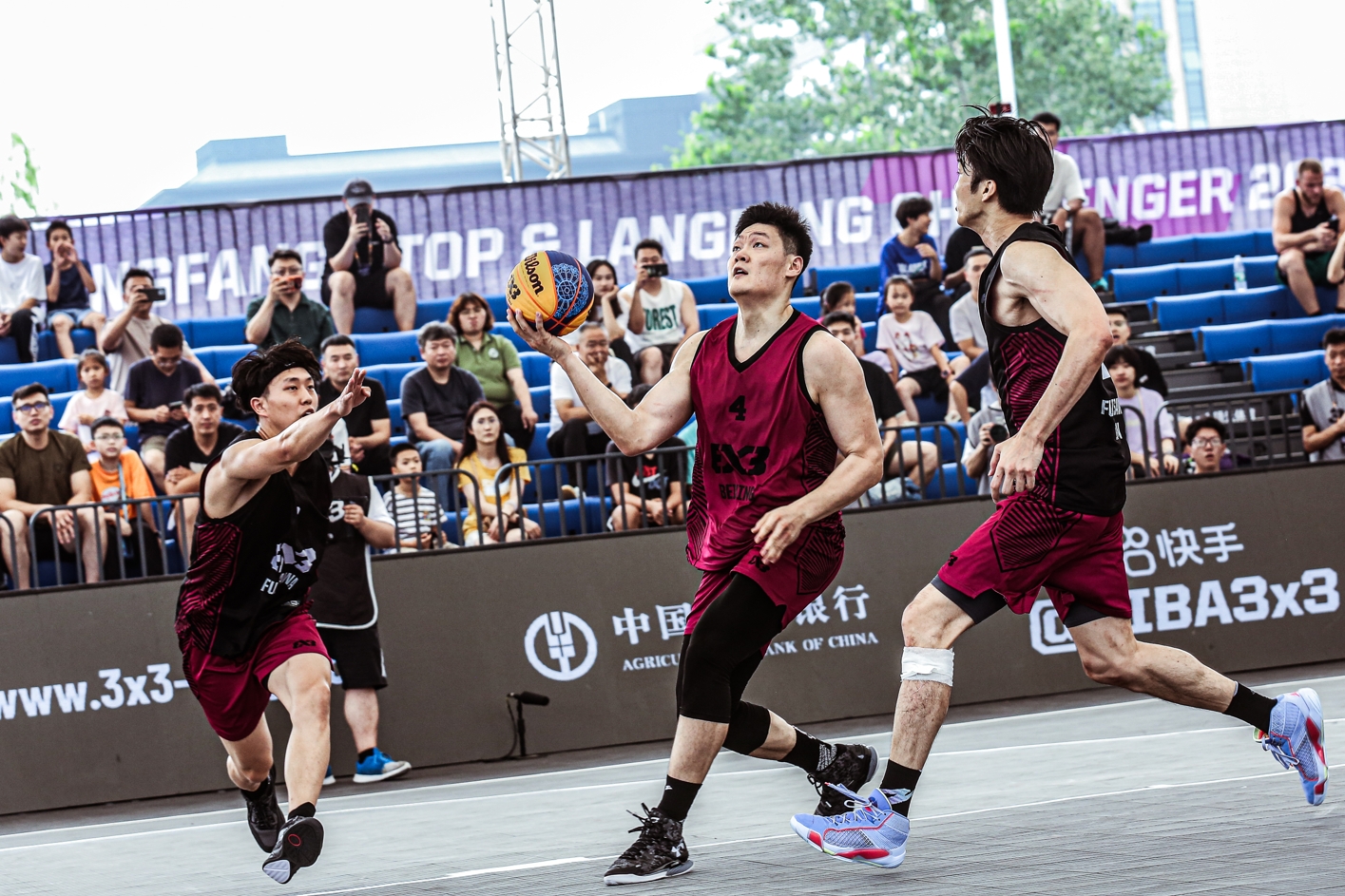Basketball is one of the most popular sports in the world, enjoyed by millions of people of all ages. Whether you’re a seasoned player, a coach, or a fan, it is important to know the standard dimensions of a basketball court.
These dimensions play a crucial role in the game and significantly impact how it is played. However, to play the game effectively, it is important to understand the court dimensions, which provide the playing area for the athletes. The dimensions of a standard basketball court are 94 feet (28.65 meters) in length and 50 feet (15.24 meters) in width, which amounts to a total area of 4,700 square feet (436.62 square meters).
In this article, we will take a closer look at everything you need to know about outdoor basketball court dimensions, including why the standard dimensions matter, how to measure a court, and the different dimensions for the NBA, high school, NCAA, and FIBA.
Why the Standard Basketball Court Dimensions Matter
The standard dimension of a basketball court is important for several reasons. Firstly, they provide a consistent playing field for all players, no matter where they play.
This ensures that the game remains fair and that players can compete on equal terms. Secondly, the court’s dimensions determine the size of the hoop, which affects how the game is played.

A larger hoop makes scoring easier, while a smaller hoop makes it more challenging. Finally, the standard dimensions of the court affect how players move and maneuver, which can impact the game’s outcome.
The Regulation Basketball Court Size and Its Importance to the Game
The regulation outdoor basketball court size is 94 feet long and 50 feet wide. The free-throw line is 15 feet from the backboard, and the three-point line is 22 feet away from the center of the basket.
The hoop is 10 feet high and is centered on the backboard, which is located 4 feet behind the baseline. These dimensions are crucial to the game of basketball and play a significant role in how it is played.
For example, the size of the court affects how players move and maneuver, which can impact the game’s outcome. Additionally, the hoop’s size affects how players shoot, as larger hoops make it easier to score, while smaller hoops make it more challenging.
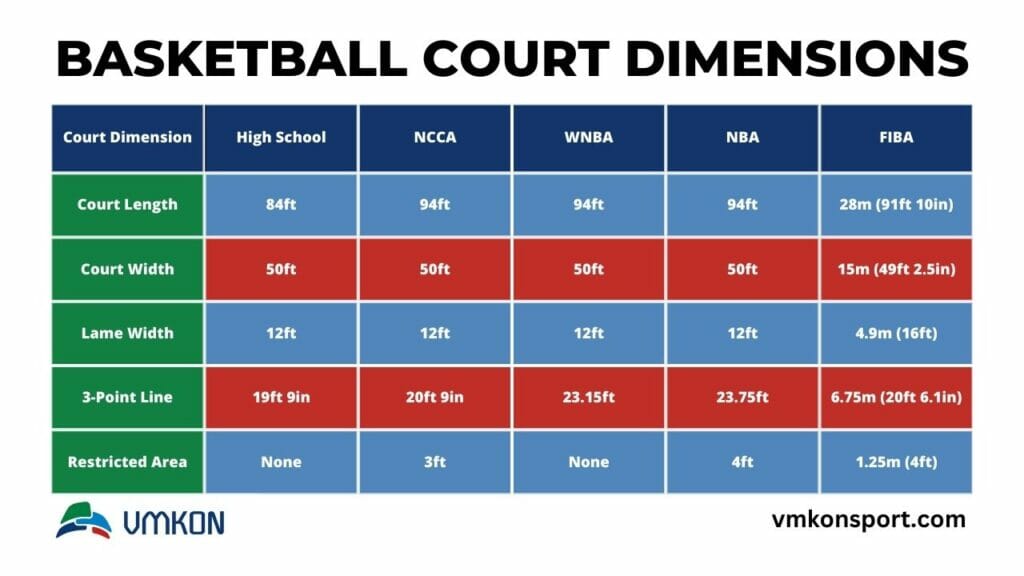
NBA Basketball Court Dimensions
The National Basketball Association (NBA) court dimensions are standardized and regulated to ensure a fair and competitive game. The NBA court is 94 feet long and 50 feet wide. In basketball, the half-court line is positioned halfway between the end lines, as its name suggests. There is usually a home team logo on the tip-off circle in the middle of the half-court line.
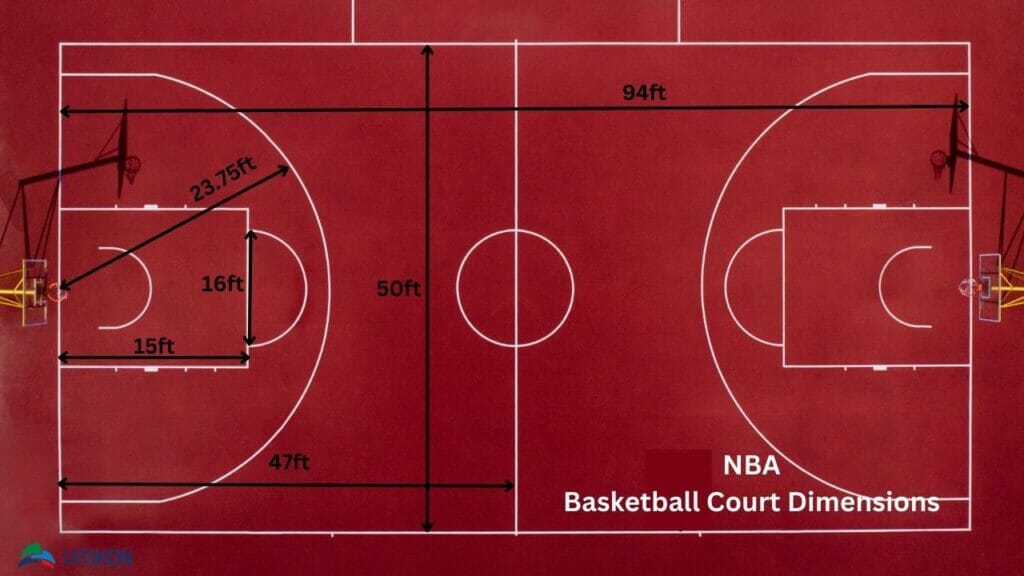
In the NBA court key, there are 16 feet between the baseline and the foul line and 19 feet between the baseline and the foul line. There is a semicircle with a radius of six feet in the area between the foul line and the foul line.
Depending on the court, there may be other rules, such as drawing a dotted line inside the key to indicate the other half of the half circle. This creates a clear boundary for any jump balls that may occur inside the key.
There are four feet of space between the backboard and the baseline, and the basket’s rim hangs 10 feet above the floor. The distance between the foul line and the front of the backboard is 15 feet once we subtract the four-foot overhang from the 19-foot key length.
As a general rule, people believe the foul line is located 15 feet from the basket center, but that is not the case. Backboards measure a maximum width of six feet and a maximum height of 42 inches.
All of these dimensions and markings help regulate the game and make it as fair and equal as possible. There is no doubt that the NBA court dimensions play a crucial role in the game of basketball.
They create a standardized and regulated playing surface that is fair and equal for all players. The court markings and dimensions are carefully crafted to ensure a safe and exciting game for players and fans.
High School Basketball Court Dimensions
High school basketball is a unique and exciting game that millions of students worldwide enjoy. While it may seem similar to its college and professional counterparts, some key differences make it distinct.
One of the most noticeable differences is the size of the court. Unlike college and professional courts, which measure 94 feet in length, high school basketball courts are 10 feet shorter and total 84 feet. However, there are some similarities between high school and other levels of basketball.
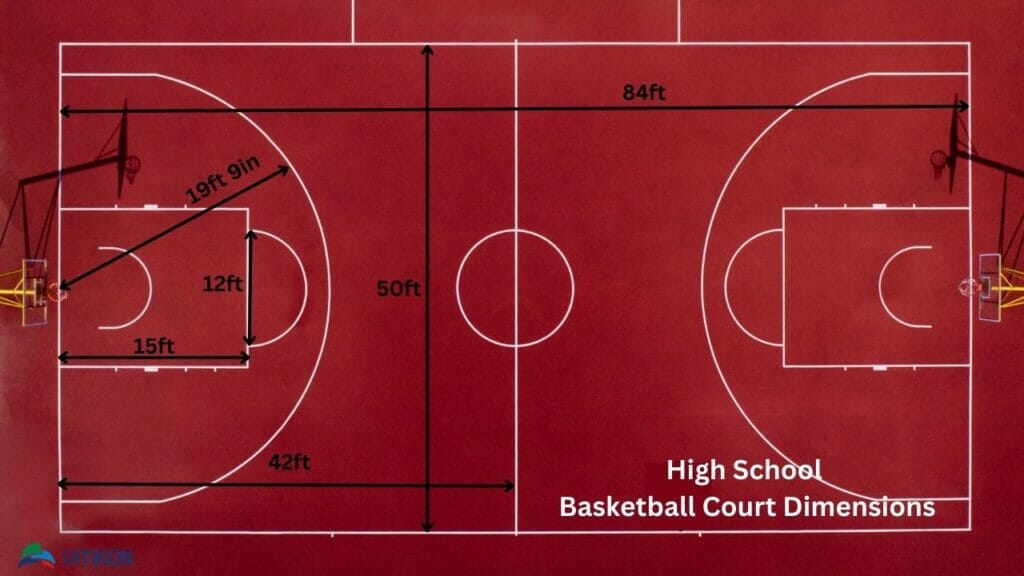
The width of the high school court is still 50 feet, and the height of the basket is the same as well, at 10 feet off the ground. The tip-off circle is also the same size, with a six-foot radius. Another aspect of high school basketball that sets it apart from its professional and college counterparts is the backboard size.
While the high school landscape isn’t as standardized as other levels of basketball, the backboard is expected to have the same measurements as the NCAA and NBA. This means that the foul line is still 15 feet from the backboard, and the key is 19 feet long, the same as in college and professional basketball.
However, the distance from the three-point line is shorter in high school basketball, with the free throw line located just 19 feet, nine inches from the center of the basket. This starkly contrasts with the NCAA and NBA, which have longer distances from the three-point line.
NCAA Basketball Court Dimensions
The National Collegiate Athletic Association (NCAA) basketball courts are similar in dimensions to those used in the NBA and WNBA. The court includes the foul line, backboard, basket height, and tip-off circle. However, a few differences in the court’s dimensions set it apart from the professional leagues.
One of the main differences is the width of the key, which is only 12 feet wide as opposed to 16 feet in the NBA. Additionally, the first box on the side of the key is located only six feet from the baseline instead of seven.
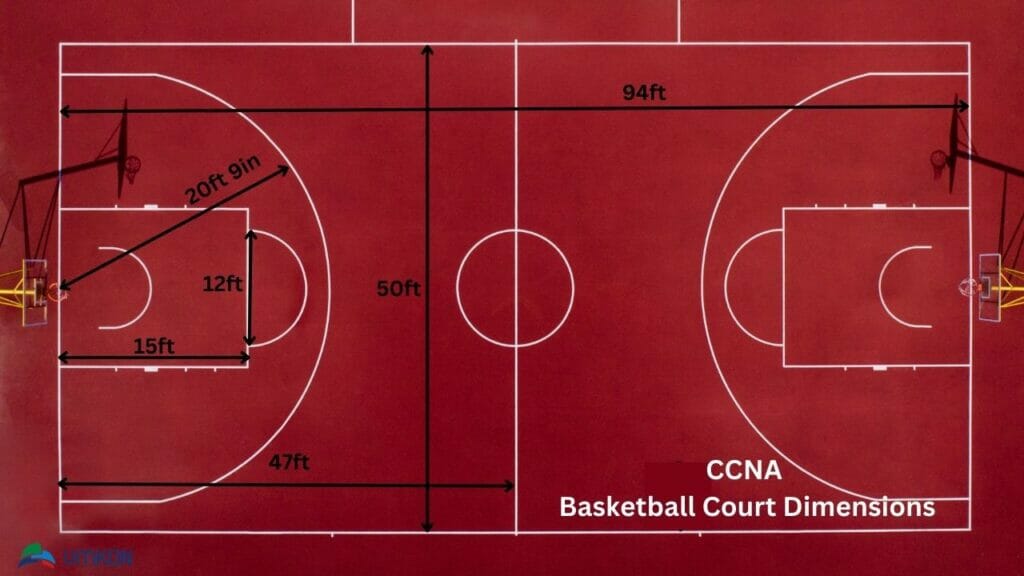
The restricted area under the basket is also smaller in the NCAA, with a diameter of only three feet compared to four feet in the NBA. The most notable difference between the NBA and NCAA court dimensions is the distance of the three-point line. The NCAA three-point line is 20 feet, nine inches from the center of the basket.
Unlike the NBA, the NCAA’s three-point line is a continuous arc from one side of the baseline to the other, without any straight lines to create space on the sidelines.
The difference in the distance of the three-point line can be a big adjustment for players transitioning from college to the professional leagues. It’s one of the reasons why it can be difficult to predict how well a player will shoot from beyond the arc in the pros.
FIBA Basketball Court Dimensions
The International Basketball Federation (FIBA) governs the game internationally. The court dimensions for a FIBA basketball game are different from those used in the United States due to the difference in measurement systems. VMKON Sports floor tiles are also approved by FIBA.
In terms of dimensions, a FIBA basketball court is 28 meters long, equivalent to 92 feet. The width of the court is 15 meters or 50 feet. The tip-off circle is smaller, with a diameter of 3.5 meters or a radius of five feet, seven inches.
The key, where players start their plays, is 5.8 meters long and 4.8 meters wide, equivalent to 19 and 16 feet, respectively. There is a 1.2-meter distance between the basket and the baseline and 4.6 meters or 15 feet between the basket and the foul line.
The restricted area under the basket has a 1.25 meters or four feet radius. The basket remains 10 feet off the ground, but the three-point line is the biggest difference between FIBA and other leagues. The three-point line at the top of the arc is 6.75 meters from the center of the basket, or 22 feet, two inches. This line is over a foot and a half closer than the line used in the NBA.
In the end, FIBA governs international basketball courts, and the court dimensions for a FIBA game differ from those used in the United States.
The difference is due to the difference in measurement systems, but the key elements of the game, such as the basket height and the tip-off circle, remain the same. The three-point line is the main difference, which is closer in a FIBA game than in other leagues.
Basketball Half-Court Dimensions
In basketball, understanding the dimensions of a half-court is crucial for players, coaches, and court builders. Whether you’re planning a backyard basketball court or simply curious about the measurements, here we will discuss all the factors of Half-Court Dimensions.
Size in overall Half-Court Dimensions.
In professional basketball and college basketball, both men’s and women’s half-courts follow the same dimensions at both the professional and college levels.
The fields span 50 feet in width and 47 feet in length, providing ample space for competitive games to be played to the fullest of their potential. However, it is important to note that high school half-courts are slightly smaller, measuring 42 feet in width and 47 feet in length, in comparison to college half-courts.
Dimensions of the free throw lane
“The key” is a well-known term used to describe the free throw lane in basketball. This area holds significant importance in the game, especially on a half-court. In the Women’s National Basketball Association (WNBA), the key measures 16 feet wide by 19 feet long.
However, there are variations in the dimensions of the key in other basketball leagues. The National Collegiate Athletic Association (NCAA) features a narrower key, measuring 14 feet wide. Similarly, high school basketball courts have an even narrower key, measuring only 12 feet wide.
Three-Point Distance.
Across different levels of play, the distance between the three-point line and the hoop varies. A three-point line in the NBA is set at a distance of 23 feet and 9 inches from the center of the hoop, which means that it is set at a distance of 23 feet and 9 inches.
Similarly, college basketball follows a similar measurement, while high school basketball has the closest line distance to the hoop, with the arc measuring 19 feet and 9 inches from the center of the rim.
Customizable Half-Court.
Suppose you want to build a half-court in your backyard or any limited space. In that case, VMKON Basketball COURTS provides exceptional and advanced flooring options for both indoor and outdoor basketball courts, ensuring top-notch quality.
VMKON SPORTS COURTS offers personalized basketball court surfacing solutions that can be adjusted to fit your available area’s precise measurements and constraints. By collaborating with expert builders, you can construct a unique half-court that caters to your individual requirements and offers an optimal playing surface for basketball.
Finally, Basketball half-court dimensions are essential for anyone involved in the sport. These dimensions that define the rules of the game, as well as the measurements of the free throw lane and the three-point line, determine the nature of the game and how it is played.
Conclusion
The perfect outdoor basketball court dimensions require careful consideration of several factors. The standard size of a court is 94 feet by 50 feet, and the playing surface should be durable and easy to play on.
The hoop should be installed securely and at a height of 10 feet, and the three-point line and free-throw line should be 22 feet and 15 feet from the center of the basket, respectively.
The court should also be painted with lines and markings, and the colors can suit your preference. With these guidelines in mind, you can build the perfect outdoor basketball court for you and your friends to enjoy. VMKON Provides the best quality FIBA Approved sports flooring for basketball if you have any queries feel free to contact us.
FAQs
What is a Good Size for a Basketball Court?
A good size for a basketball court is 94 feet long and 50 feet wide. This size is the standard for both professional and collegiate basketball courts. It allows for plenty of room for players to move around and play the game safely and effectively.
How Thick Should an Outdoor Basketball Court Be?
Materials used to construct outdoor basketball courts should determine the thickness. Typically, outdoor basketball courts are about 4 inches thick.
What Size Slab for Backyard Basketball?
The slab size for a backyard basketball court will depend on the available area and the type of game you plan to play. Generally, a slab of 6 meters by 12 meters (20 feet by 40 feet) is ideal for a single game of half-court basketball, while a larger slab of 9 meters by 18 meters (30 feet by 60 feet) is recommended for a full-court game.
How Many Square Feet is a Basketball Court?
A regulation-size basketball court measures 94 feet by 50 feet, which equals 4,700 square feet.
How big is a basketball court in square meters?
A standard basketball court is 28.65 meters long and 15.24 meters wide, which amounts to a total of approximately 436.62 square meters.




